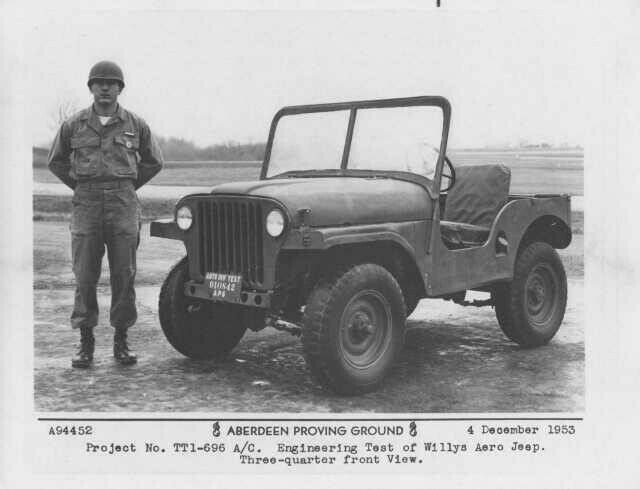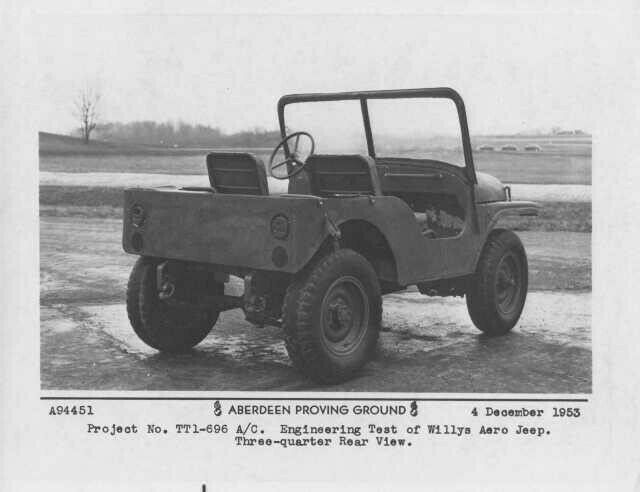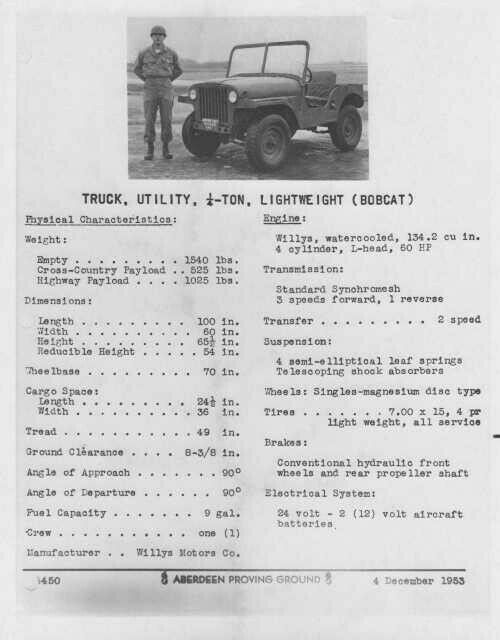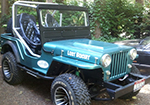A March 25, 1941, set of photos in the Kansas City Star shows a Bantam BRC-60 flying high at one point, but then being dragged across a river by a horse at another point.
Airborne Lightweight Jeeps Research Archives
1960 CJ-3B Rifle, CO $5500
UPDATE: Price dropped to $5500.
(03/02/2016) “60 Willy’s jeep all original motor and drive train, motor completely rebuilt. New crank pistons, rods, valves, etc. 4 wheel drive all works good.”
https://westslope.craigslist.org/cto/d/silt-60-jeep-willys/7090510714.html
Previous pics below:
1954 Photo of Aero Jeep Airborne Prototype
UPDATE: These two pics are currently on eBay.
- 1954 Willys Aero (Bobcat) Airborne prototype (From front):

- 1954 Willys Aero (Bobcat) Airborne prototype (From rear):

- (Reproduction) Aero Bobcat Spec Sheet.

====================
Original post 2014: This is a collection of Aero Bobcat Airport jeep photos. A couple may still be on eBay
1. “A vintage 1954 original photo depicting Willy’s Aero Jeep undergoing test at the proving grounds at Aberdeen MD. Original press stamp and caption with a JAN 8 1954 stamp date are on the verso.”
Odd Vehicle
Apparently, this is located in Bavaria … Photos of this vehicle were posted to the G503 Facebook page. Some folks saw this as a bubbafied vehicle, and there may be elements of that. However, the bends of the frame and other nuances have me wondering if it was some type of airborne prototype. It’s actually a pretty clean frame for a bubba project. In a couple pics you can see how clean the spring hangers have been mounted.
Thoughts?
Check out the grille. You can see that it has equidistant slats up until the right side. I don’t see Bubba doing something like that so cleanly. 


1943 Photos of the Chevrolet Airborne Prototype on eBay
This seller has a series of photos of the Chevrolet lightweight prototype.
“1942 Chevrolet US Army 1/4 Ton Jeep Truck Prototype Press Photo. Original
Details: W 10 x H 8 x D 0.1”
2. View all the information on eBay
“1942 Chevrolet US Army 1/4 Ton Jeep Truck Chassis Prototype Press Photo. Original
Condition: Looks as though it was likely cut from an 8×10, possibly had two photos on 8×10 sheet”
3. View all the information on eBay
“1942 Chevrolet US Army 1/4 Ton Jeep Truck Prototype Press Photo. Original
Details: W 10 x H 8 x D 0.1″
Sam Werner Military Museum
I saw this one Facebook. I didn’t realize that the Sam Warner Military Museum in Tennessee had such an extensive collection of jeeps, including some airborne prototypes. I will make it a point to visit there during my May trip.
“Gypsy Rose Lee” Airborne Jeep
The Gypsy Rose Lee Jeep is a stripped down version of the regular jeep for airborne troops (one of a variety developed). Made of “plastic plywood”, it was almost a 1,000lbs lighter than the standard 2,200lb jeep. You might also know the jeep as the MB-L. This article, of which the Gypsy Rose Lee was a part, was published in the December 1947 issue of Willys Overland Unity Magazine.
H.C.L. Sieberg Netherlands “Peace Jeep” Importer
The Netherlands firm of H.C.L. Sieberg began selling jeeps in 1946 after acquiring 1400 jeeps from an army depot. The firm bought an additional 1000 jeeps. In May of 1946 Director L.F.J. Mählmeijer visited Toledo to secure an agreement for supply Sieberg with parts. Sieberg got permission to import four CJ-2As, called the “peace jeep” in the Netherlands, for demonstration purposes. It was an uphill battle, but overtime, the government allowed the company to import more jeeps for agricultural purposes.
Below are some examples of Sieberg brochures printed in Dutch. Thanks to Charles for sharing these photos. The photos and the history was published at conam.info in Dutch. You can read an english translated version of the page here.
British Lightweight 4WD ‘jeep’ from 1958
Marc spotted this article about a 500lb lightweight airborne jeep-like vehicle from a post on Jalopnik. The vehicle was feature in the July 1958 issue of Popular Mechanics (pg 83). It demonstrates that the lightweight airborne program that started during WWII was still ongoing.
Crosley ‘Pup’ Variant – Photo on eBay
This appears to be a variant of the Crosley Pup (see post from Jan 1). The size, the front end and the wheels look similar. The fenders are rounded. Possibly it is a prototype?






















